Turtles are one of the easiest ways to get started in the animal-keeping world.
Being relatively small, unfussy, and (incredibly cute) low-tech creatures, their fundamental habitat really is quite simple. But there are good reasons to go beyond the boring plastic box.
A vibrant, interesting turtle terrarium is infinitely better for both the turtle and its keeper.
We have the opportunity to create their very own semi-aquatic paradise and a beautiful piece of botanical art for our home. That’s much better right?
So in this guide, we’re not covering the basics of pet turtle care, we’re exploring ways to create a genuinely dynamic environment for them to thrive.
Let’s get into it!

Terrarium Tribe is reader-supported. When you purchase through links on our site, we may earn an affiliate commission (at no further cost to you). 💜
Key Turtle Terrarium DIY Accessories
Okay, so before we dive into tank setup ideas, let’s take a second to consider our turtle habitat.
Being a semi-aquatic species, they need a semi-aquatic environment. But just how much water vs land they need will depend entirely on the species of turtle.
For some, that means they’ll need a typical vivarium setup plus a small water pool (e.g., this box turtle build on YouTube). Whereas you’ll need a more expansive water tank for others, so a true paludarium build is more appropriate (like this one).
Either way, make sure to check their individual needs first!
That said, whichever you choose, the ideas and themes in this guide should be universal.
We’ll be using natural materials (where possible) and suitable terrarium plants to create an enriching environment where a turtle can explore, hide, and chill to its heart’s content. Partly so that our turtle friends will feel comfortable as if they’re in the wild, but also just because they tend to look better.
Though, I’m certainly not ruling out a little Atlantian paradise if you have some stone figurines and statues lying around…
Plants
The single best addition to your turtle terrarium is going to be plants. Without question.
Plants are the paint to your canvas in any terrarium environment, but they’re also an important part of any healthy ecosystem. Filtering and oxygenating the air and/or the water.
Your turtle will feel right at home amongst the foliage, and the psychological benefits are easy to understate. Just make sure you choose those that are safe for turtles…
With the right setup, you can have any combination of terrestrial and aquatic plants in a paludarium. The easiest way is to probably go with 100% semi-aquatic plants as these can work both in and out of the water (plus they’re by on large safe for turtles).
Look for plants like Anubias, Bucephalandra, Java Ferns, and Dwarf Hair Grass.
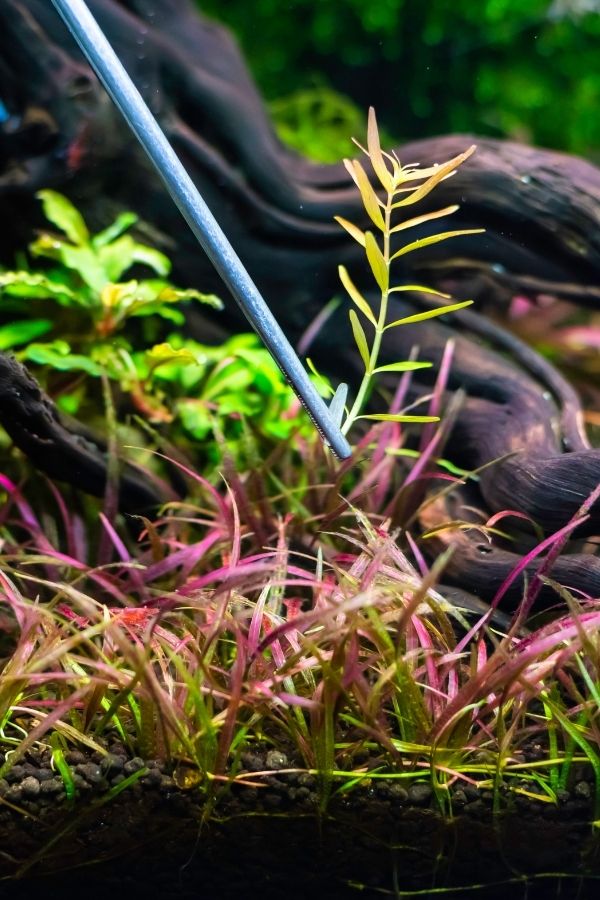
And don’t forget moss and lots of it! Java Moss is a versatile option that can thrive underwater and on land in high-humidity environments.
👉 Check out my guide to paludarium plants for more help.
Marimo Moss could be another interesting low-tech option (though they’re currently suspended in the US). Technically it’s an algae, but it’s an easy, maintenance-free addition to a tank.
Rocks
Rocks are a natural choice for any semi-aquatic setup.
They’ll easily sink in water, look natural in any location, and can provide a wide range of textures and shapes.
Though any rocks will do, aquascaping rocks come with many extra benefits.
Rocks like Dragon Stone and Seiryu Stone are visually dramatic and (relatively) lightweight, so they’ll pose less of a risk of smashing the glass.
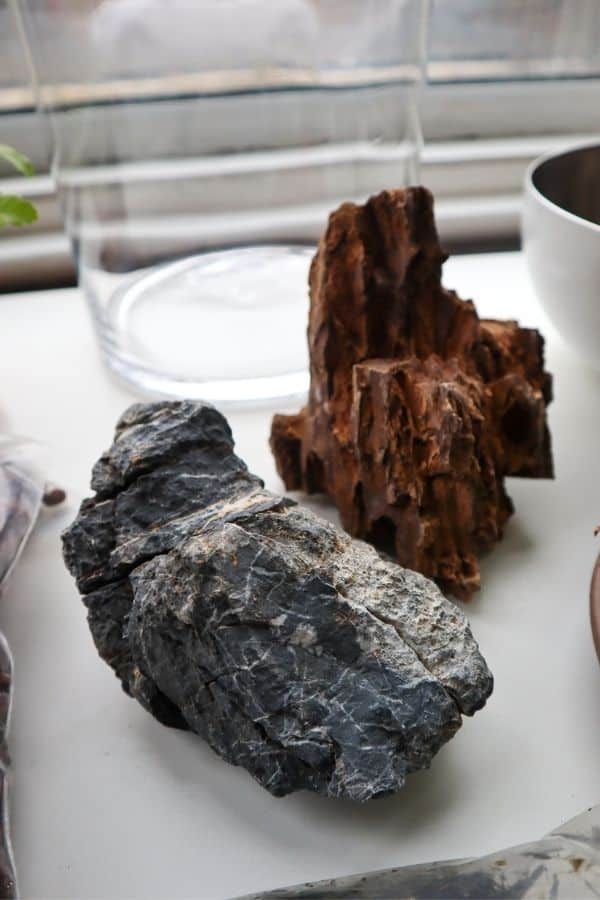
How about some little rocky outcrops, lone pillars, or mountainous backdrops?
👉 Shop aquascaping stones on Etsy.
Driftwood
Driftwood branches are a wonderful way to add some dynamic shapes that can really elevate a scene.
They also add some much-needed structural height, bringing depth and 3D planting opportunities.
You’ll want to choose hardwoods, as these can handle being submerged without falling apart or leaching compounds into the water.
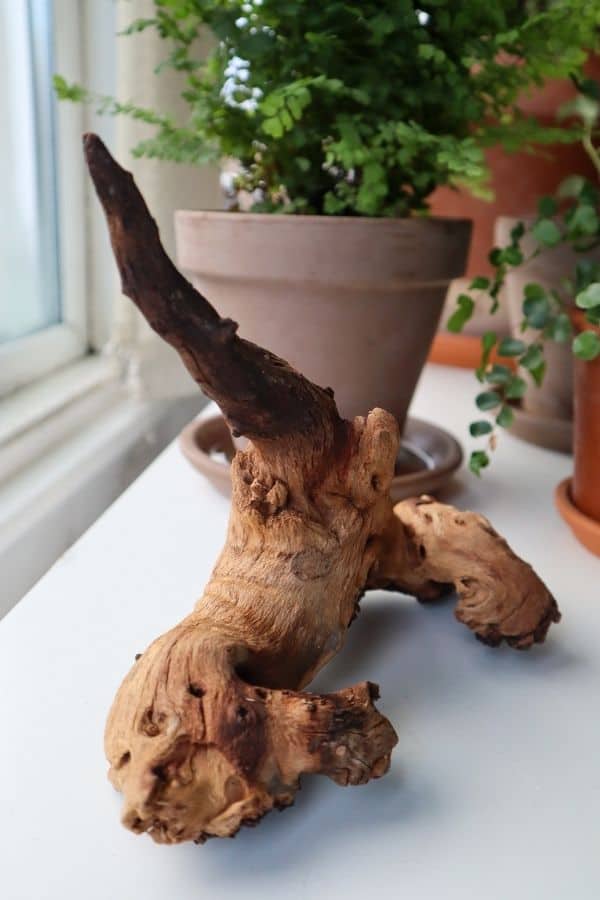
Figurines & Statues
So I know I said natural is best for a terrarium setup, but I am partial to a well-placed little figurine.
Whether that’s a little diving man, a sunken ship, or even a dinosaur (hey, it’s your world, you do you), you can add a little flair with minimal effort.
👉 Shop cool aquatic decorations on Etsy.
Turtle Terrarium Ideas + Setup
Now, onto the meat of this topic.
Here are some ways in which we can combine our materials and accessories to create a dynamic terrarium environment for turtles.
1 | A Forest
Underground or overground, every naturalistic terrarium tank needs a forest (in my humble opinion).
A collection of plants for your turtle to explore and hopefully not eat…
You don’t need to cover your container to get the feel of a dense forest. By strategically clustering plants together and choosing complementary textures, you can easily create the illusion of density.
Ferns (aquatic or otherwise) are the best way to achieve this.
2 | A Cave
Turtles like to have a hideaway spot.
Somewhere for them to relax away from prying eyes, and we can use a variety of our accessories and materials to create one.
The easiest (and possibly coolest) method is a cave.
Stacking three pieces of aquascaping stone is the most effective way, but it can be challenging to balance on land and underwater. That’s why I’d recommend buying the base and the back of the cave into a sloped substrate.
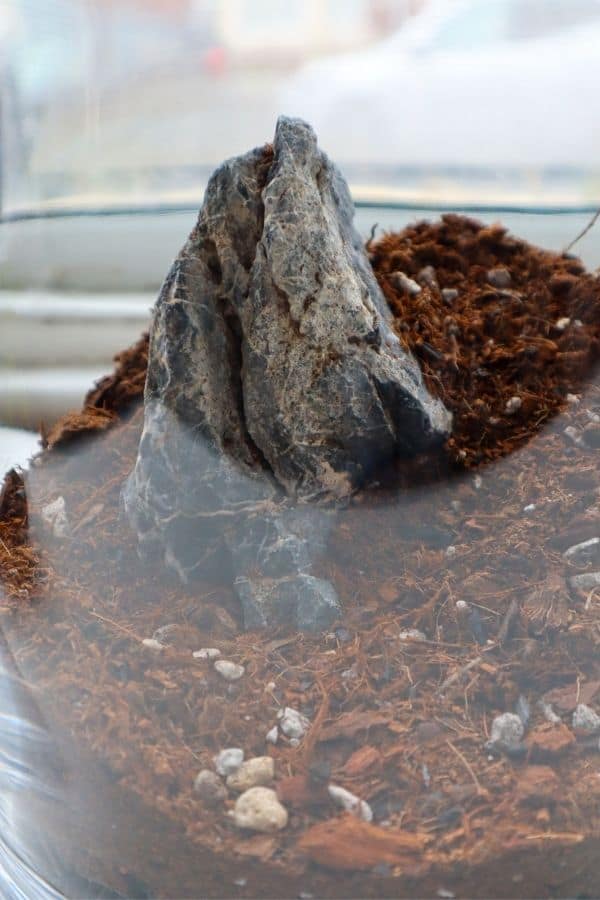
That foundation will help secure everything in place. Plus, it looks super natural and provides extra planting opportunities to bring it to life.
Alternatively, a driftwood log cut in half is a quick solution!
3 | Background
A naturalistic terrarium background helps us threefold:
- Provides a natural visual backdrop that frames the space and contrasts the contents.
- Creates epiphytic planting opportunities at all levels.
- Reduces the risk of stress and injury through swimming against the glass (more on this in a second).
To create a contained visual environment, the less glass on show, the better. Being able to see through a container on all sides only serves to integrate it with the room it’s in.
That’s why a naturalistic terrarium often has an opaque background on three sides or has some blacked-out.
This is especially helpful with turtles. Sadly they typically aren’t quite bright enough to recognize the invisible barrier that is glass, and they have been known to hurt themselves endlessly trying to get through.
You can DIY it with expanding foam and hardscape to create a background. Or, you can buy ready-made backgrounds that will slot right in (like this one).
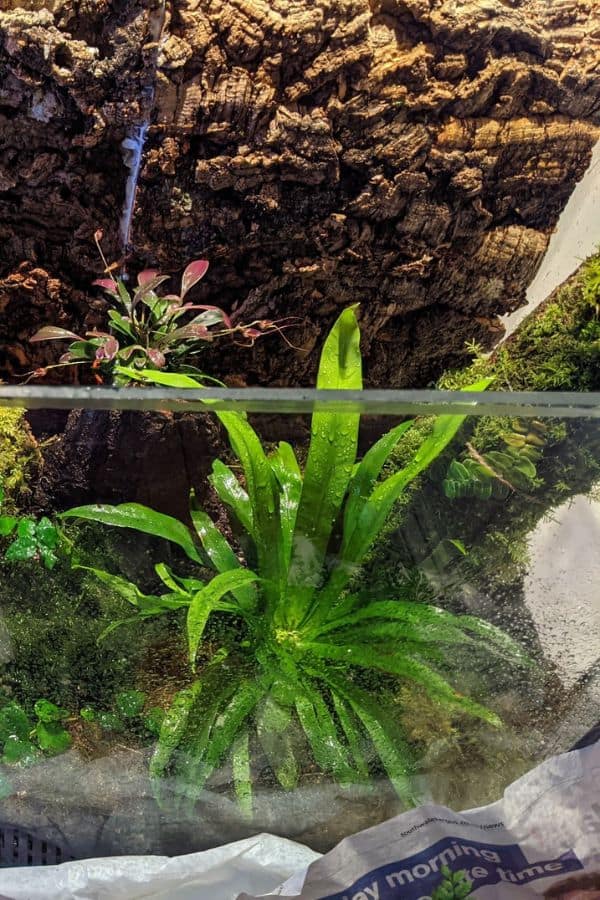
4 | A Waterfall
Nothing says spectacular semi-aquatic environment quite like a waterfall.
A way to bring movement to water above and below the water line. It also helps oxygenate and circulate the water, so it has benefits beyond being visually awesome.
If you’re DIY-inclined, you can make your own using a mix of aquaspacing rocks, pipes, and a pump. However, you can buy waterfall kits of all kinds too.
Foggers can have a similar (if not more dramatic) visual effect.
5 | Marimo Moss Tree
Last but by no means least, we have the more unusual option.
Marimo Moss is an easy option for low-tech aquatic tanks that take very little maintenance. Plus, turtles seem quite to like it.
But besides simply laying sound moss balls around for them to play with, we can use them to create some fantastic natural art.
Simply grab a chunk of driftwood with a thick branch leading to many smaller ones (like this chunk of Manzanita Wood), and then attach your moss balls all around the smaller branches.
The result is a lush, fluffy underwater tree!
Over to You
Which of these turtle terrarium ideas will you implement in your tank next?
Let me know!
Or, check out our terrarium basics guide if you need any help getting started with a simple planted setup.
